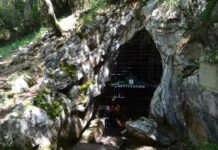Guiddoo es una empresa que realiza guías interactivas turísticas para «teléfonos inteligentes», nos cuenta en el blog de su web que en breve tendrá disponible una de sus guías dedicada a la Estación Ballenera vasca de Red Bay. Un elemento único y extraordinario, del que ya hemos hablado en numerosas ocasione sen nuestra web, que recoge el paso de los marinos vascos por esa parte del Continente americano y que acaba de ser declarado Patrimonio de la Humanidad por la UNESCO.
Su importancia queda claramente explicada en el blog:
Red Bay, set up by Basque mariners during the sixteenth century at the north-eastern tip of Canada on the shore of the Strait of Belle Isle is such an archaeological site, which provides the best, complete and earliest preserved testimony of the European whaling tradition… It became an important source of whale oil which was shipped to Europe where it was used for lighting purpose. This site, which was used during the summer months, includes remnants of a cemetery, temporary living quarters, wharves, cooperages and rendering ovens together with underwater remnants of whale bone deposits and vessels.
(Red Bay, creado por los marinos vascos en el siglo XVI, en el extremo nororiental de Canadá en la costa del estrecho de Belle Isle es un sitio arqueológico, tales, que ofrece el testimonio mejor, completa y más antigua conservada de la tradición ballenera Europea … Se convirtió en una fuente importante de aceite de ballena que fue enviado a Europa en donde fue utilizado para el propósito de la iluminación. Este sitio, que fue utilizado durante los meses de verano, incluye restos de un cementerio, viviendas temporales, muelles, tonelerías y hornos de representación junto con los restos bajo el agua de los depósitos de huesos de ballenas y embarcaciones….)
Nos será muy útil cuando vayamos a visitar este enclave de la historia de los vascos
Guiddoo – 30/8/2014 – USA
Red Bay Basque Whaling Station: A Cultural Place Of Great Universal Value

Red Bay, set up by Basque mariners during the sixteenth century at the north-eastern tip of Canada on the shore of the Strait of Belle Isle is such an archaeological site, which provides the best, complete and earliest preserved testimony of the European whaling tradition. Gran Baya, as it was known to those, who laid the foundation of the station in 1530s, was used as a base for rendering, butchering and coastal hunting of whale fat by heading to yield oil and make arrangement for storage. It became an important source of whale oil which was shipped to Europe where it was used for lighting purpose. This site, which was used during the summer months, includes remnants of a cemetery, temporary living quarters, wharves, cooperages and rendering ovens together with underwater remnants of whale bone deposits and vessels. This station was used for 70 years, prior to the depletion of the local whale population.
(Sigue) (Traducción automática)
Last Updated on Sep 1, 2014 by About Basque Country































